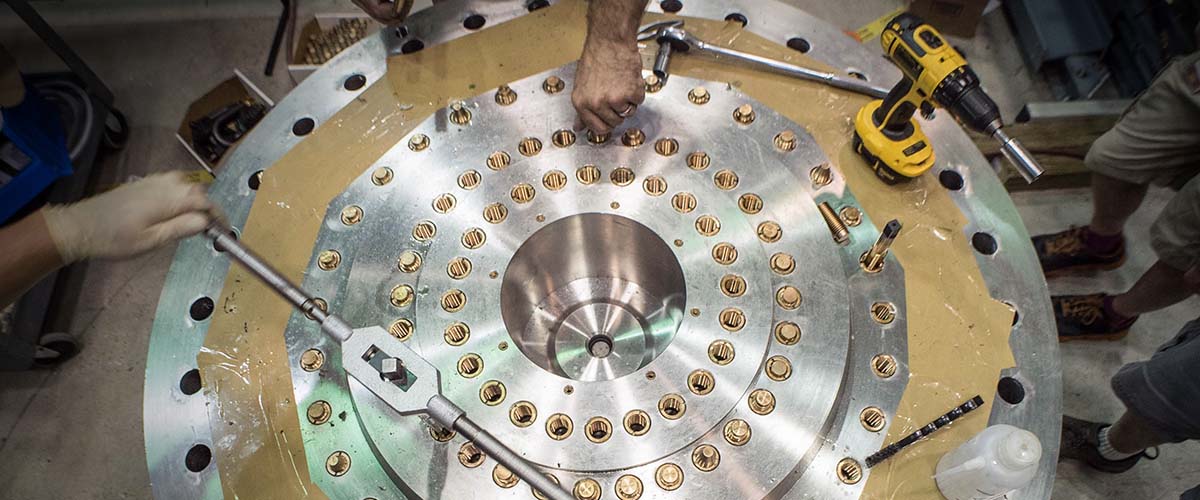
Members of the Magnet Science & Technology group are active in research areas pertaining to magnet development.
The strength of materials used in magnets is the limiting factor in the attainment of the ever higher magnetic fields. Research on conductors and structural materials to improve their strength, durability and function in the high field magnets is focused in the following areas:
The goal of the study of fabrication routes for the conductors (Cu, Cu-Ag, Cu-Nb, and Cu+Al2O3) is to make higher strength conductors with desired cross-section and properties. Strain hardening introduces nanostructure and crystallographic lattice distortion that affects the elastic-plastic transition. More severe lattice distortions were found in Cu-Nb (fcc-bcc composite) than Cu-Ag (fcc-fcc composite) conductors resulting in a more rounded stress-strain curve. The deformed Cu+Al2O3 materials have an abrupt elastic-plastic transition because the nano-particles are not shear-susceptible, limiting lattice distortion. Lattice distortion is related to the fatigue and affects the service life of pulsed magnets.
Magnet reinforcement materials (cobalt-nickel alloys and high purity maraging steels), are strengthened mainly by dislocations, coherent defects, or precipitates a few atomic layers thick. These materials have a higher Young's modulus than currently available materials such as stainless steel. Optimized fabrication routes for MP35N alloys have provided reliable 77 K ultimate strengths of 2500 MPa and survive > 2000 cycles at 2300 MPa.
Currently, macro-composites made of stainless steel jacketed Cu, Cu+0.3wt%Al2O3 and Cu+1.1wt%Al2O3 have been fabricated that have the potential to achieve high strength with large cross-sections. We also studied Cu+SiC composite with 295 K strength of 1300 MPa and conductivity of 70% IACS.
The exploration of new conductors concentrates on cryogenic deformation of Cu and Cu+Al2O3. Preliminary results indicate that the low temperature deformation indeed introduces more strain hardening in Cu+Al2O3 conductors at low strain levels.
For more information contact Ke Han.
The application of HTS materials is the future technology required to make high-field magnets more energy efficient. The conventional technical superconductors (Nb3Sn and NbTi) are limited to applications where the magnetic field is < 20 T whereas the HTS materials of interest retain excellent 4 K superconducting properties in magnetic fields > 30 T. The development and fundamental research on HTS materials is ongoing elsewhere in the MagLab's Applied Superconductivity Center.
MS&T's applied research is focused on two popular HTS materials (YBCO and Bi-2212) and their use in high-field magnet design and operation. Both of these conductors are complex and delicate, so the extremes of the operating requirements must be evaluated in tests of the electrical properties, mechanical properties and the combined electro-mechanical performance. MS&T has developed expertise, techniques and equipment to evaluate these unique conductors. A comprehensive study of the combined electro-mechanical performance of YBCO has been conducted in support of the all-superconducting 32 T magnet. For details see 77K Characterization of YBCO Coated Conductors and Joints.
There is significant interest in Bi-2212 since it can be fabricated in round wire form, a preferred geometry for solenoid magnet and HTS cables. Careful characterization of the stress-strain behavior of the soft Ag clad wire is ongoing. For more information see Tensile Properties of Ag Alloy Clad Bi-2212 Round Wires (presentation, 2009) or Tensile tests on 100 bar heat treated Bi-2212 round wire at 4.2 K (memo, 2014).
For more information, please contact Jun Lu.
The conduit alloy research projects ensure the reliability of this major structural component in SCH magnets. For details, see SCH - CICC Fatigue Life Considerations.
The US-ITER project at ORNL is engaged in collaborative research with us to qualify structural and electrical materials used in the fusion reactor's large magnets. Two reports on conduit alloy research conducted at NHMFL for US-ITER, have been presented at the 2011 and 2009 CEC/ICMC Conferences. For details, see Cold Work Study on a 316LN Modified Alloy for the ITER TF Coil Conduit, presented at the 2011 conference, and Mechanical Properties of Modified JK2LB for Nb3Sn CICC Applications, presented at the 2009 conference.
Both magnet projects require the use of specialty alloy 316LN in high cyclic fatigue stress applications. The limited database available prompted the generation of the 4 K fatigue data presented at the 2009 CEC/ICMC Conference. For details, see Fatigue Properties of Modified 316LN Stainless Steel at 4 K for High Field Cable-in-Conduit Applications (PDF, 352 KB), presented at the 2009 CEC/ICMC Conference.
For more information on superconductor research and MS&T research, please contact Jun Lu.
Last modified on 16 February 2024